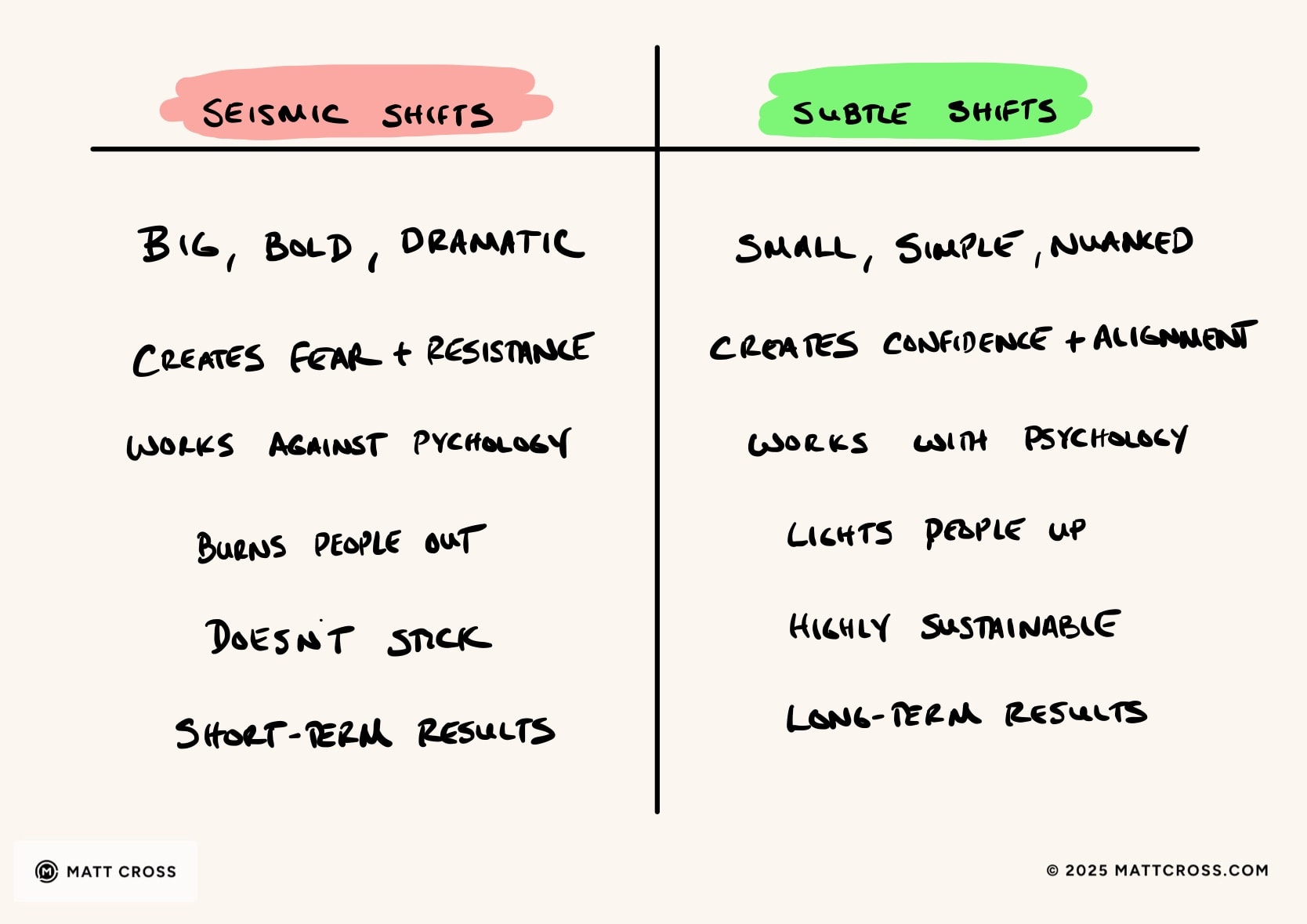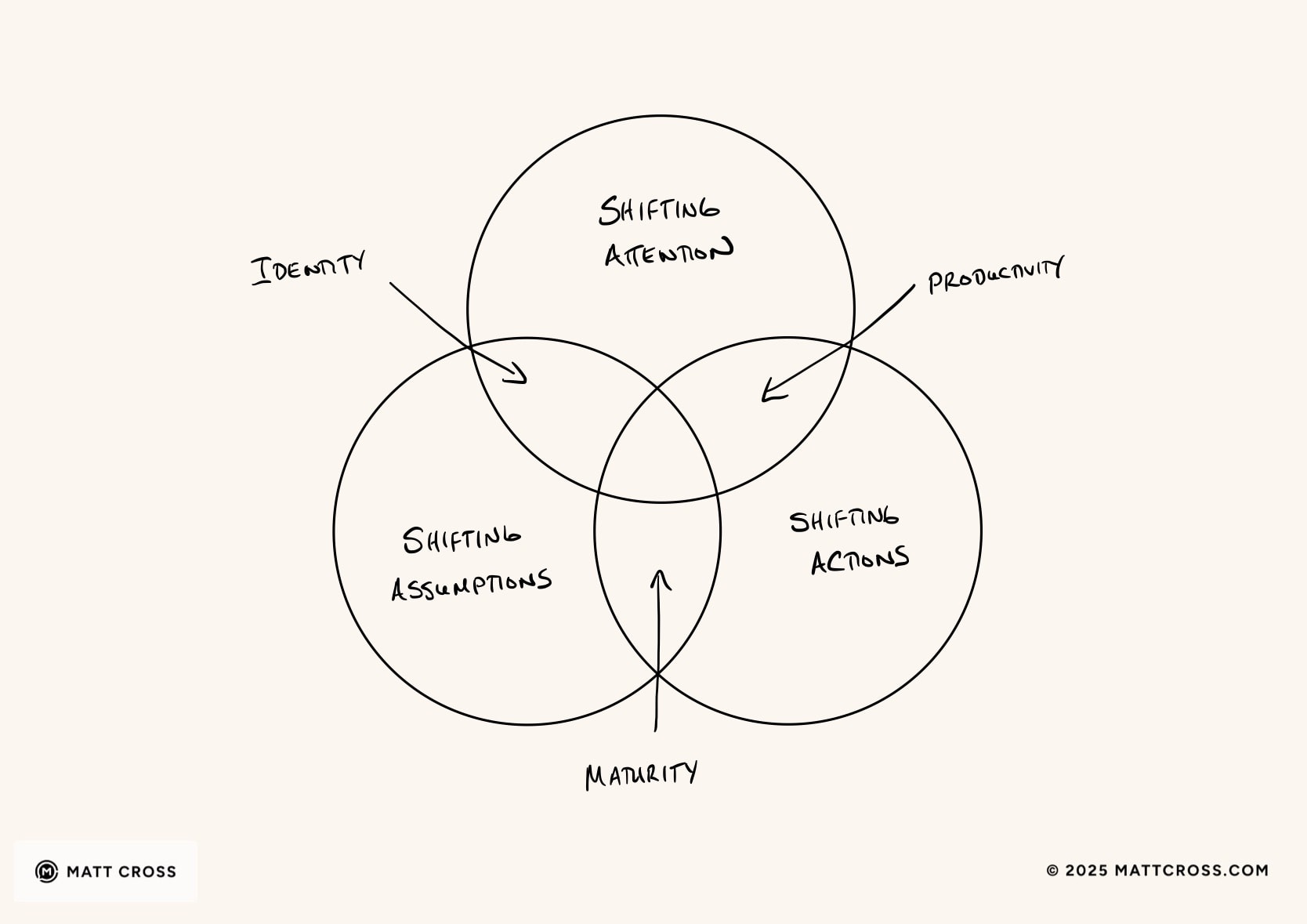Subtle Shifts are small, intentional changes in attention, assumptions, and actions that leaders make to create lasting impact. Unlike dramatic overhauls, they are practical, sustainable moves that reduce resistance and build momentum.
- They are not quick fixes.
- They’re not shortcuts.
- They are like small hinges that swing big doors
They act like subtle, elusive mechanisms that affect our leadership, communication, teamwork, productivity, and personal satisfaction.
Let’s expore this further so you can see the important role they play in leadership, life, and many other domains.
Why Subtle Shifts Matter
We all face similar challenges in life. Change is constant, and people resist it. This affects our own lives, but it is particularly important for leaders and managers.
Organizations pour time and money into bold initiatives, sweeping programs, and ambitious transformations. But more often than not, those efforts collapse under their own weight. People get burned out, emotional energy drains, and performance slips. Instead of moving forward into the future, teams end up stuck in tension, weighed down by stress and anxiety.
The truth? Change doesn’t fail because people don’t care. It fails because the approach is too heavy-handed. Leaders plan for weeks and use a variety of techniques, but underestimate the power of small, intentional moves.
That’s where Subtle Shifts come in.
Subtle Shifts are a way of leading and navigating through change without forcing it. Instead of dramatic overhauls that demand people reinvent themselves overnight, Subtle Shifts emphasize incremental adjustments that restore energy, reduce overwhelm, and create lasting results. They work because they feel natural, sustainable, and safe.
Why Big Change Fails
Before we dive deeper, it helps to contrast this approach with traditional approaches to change.
Most organizations default to big, bold change: sweeping programs, re-orgs, and dramatic overhauls. I call these seismic shifts, and they are what we’ve all witnessed when leaders talk in grand visions and push for big bold changes. John Kotter told us years ago why tranformation efforts often fail and he was right.
The problem with this approach is simple:
- Energy fades. Large-scale change creates a mental and emotional energy dip.
- Fear rises. High-stakes initiatives trigger anxiety and tension.
- Resistance hardens. People push back when they feel forced.
- Confidence collapses. When big programs fail, trust in leadership erodes.
This is what I call the Transformation Trap, and it is a game we play week in and week out. We chase radical change while overlooking the quiet power of small, sustainable moves.
Subtle Shifts offer the antidote: calm, clarity, and momentum through small, steady steps.
Subtle Shifts vs. Seismic Shifts
There are clearly two very different approaches to change. Seismic shifts are dramatic, large-scale transformations that often demand rapid, sweeping action. They can feel overwhelming, disruptive, and sometimes even intimidating, as they require people to adapt to new realities quickly. While big, bold change may promise fast results, it often doesn’t produce the results we expect because it triggers resistance, burnout, and loss of emotional energy.
Subtle shifts are very different. They feel natural and sustainable because they work with human psychology rather than against it. Instead of forcing change or thrusting it upon others, they invite curiosity, reduce overwhelm, and restore emotional energy. They create space for learning, experimentation, and alignment, allowing individuals and organizations to evolve with poise.

Personal Transformation Precedes Organizational Transformation
If big, bold change often leaves people overwhelmed and stuck, then what’s the better path?
The alternative is simple: create change through Subtle Shifts.
Subtle Shifts bring a sense of calm to the change process. Instead of amplifying tension, they release it. Leaders don’t have to rely on grand speeches or complicated campaigns. Real transformation begins in a quiet conversation. When a leader shares a short story, asks a thoughtful question, or adapts their own mindset, they are playing with new approaches and experimenting with adjustments that open the door for others to follow.
The beauty of Subtle Shifts is that they restore joy to the growth process. Teams begin to see progress without feeling pressured. Individuals and teams heal when changes release energy and support a healthier and more harmonious environment. Instead of avoiding disruption, people gain insights that spark curiosity and possibility.
This approach also draws on a deeper kind of wisdom. Rather than assuming change must be fast and dramatic, wise leaders recognize that the most potent growth often comes through steady, intentional adjustments. In doing so, they create an environment where people feel safe, engaged, and ready to move forward, one small step at a time.
The Subtle Shifts Framework
Subtle Shifts happen across three dimensions every leader can access:
- Attention – What you attend to shapes what grows. Leaders who can move attention from what’s urgent to what truly matters create clarity and alignment.
- Assumptions – The beliefs you hold (often unconsciously) drive your leadership. Adjusting assumptions unlocks new possibilities and creative solutions.
- Actions – The choices you make, even small ones, send powerful signals. Choosing new actions builds trust, momentum, and results.
These three—Attention, Assumptions, and Actions—intersect like a Venn diagram. The sweet spot occurs when all three align: your focus, mindset, and presence reinforce one another. That’s when change feels effortless, people feel a positive sense of emotional energy, and results multiply.

Why Subtle Shifts Work: Emotional Energy
Leaders often ask: Why go small when the problem feels so big?
The answer lies in psychology, organizational science, and human energy:
- They bypass resistance. Neuroscience reveals that our brains instinctively push back against threats. Big change feels threatening; Subtle Shifts feel safe.
- They build momentum. If you are struggling, feeling stuck, or negative, you have to break the pattern. Even the smallest adjustment can restore emotional energy and create the clarity you need to move forward. Subtle Shifts help you build momentum because they are simple.
- They’re sustainable. Because they don’t demand all-or-nothing commitment, Subtle Shifts reduce overwhelm and restore emotional energy. Once a mindset shift occurs, it tends to last.
- They ripple outward. A leader’s subtle change often transforms the culture. For example, when a leader pauses before reacting, they stay calm and make it safe for others to speak up.
Subtle Shifts can also help our bodies release stress and tension, supporting overall well-being.
Instead of draining energy, they generate it.
Subtle Shifts and Mindset Shifts
At first glance, subtle shifts may seem like mindset shifts, but they are so much more than that. They are the secret to success in almost any endeavor: life, leadership, communication, teamwork, productivity, and happiness. When we think about the pathway to flourishing, it doesn’t merely come down to habits or mindset shifts. It depends on a fundamental change in how we make sense of the world. I’ll explain more later, but for now, let’s look at how this shows up in different domains.
Subtle Shifts in Leadership
Bold speeches or sweeping initiatives don’t define leadership. The leaders who make a lasting impact are the ones who master the art of subtle adjustments. They make small adjustments in their daily appearance to establish credibility, trust, and influence. The changes may look minor from the outside, but they dramatically reshape how teams experience their leader and how organizations move forward. Here are four powerful examples:
- From giving answers → to asking better questions.
- From managing tasks → to inspiring ownership.
- From solving problems → to developing problem-solvers.
- From operating in isolation → to mastering executive presence.
When practiced consistently, these subtle changes enable organizations to move from a reactive or responsive state to a creative and generative one.
Subtle Shifts in Communication
Subtle shifts in communication transform how leaders connect with their teams and stakeholders. Communication breakdowns are one of the most common causes of conflict and lost productivity. By making small yet intentional adjustments, leaders can foster trust, enhance clarity, and cultivate a culture of open dialogue.
- From speaking first → to listening first.
- From long explanations → to short, clear direction.
- From assuming understanding → to checking for clarity.
- From ignoring the audience → to tailoring messages to their needs.
These changes may seem minor, but they are a game-changer. They are between a team that feels informed and aligned versus one that feels frustrated and disengaged.
Subtle Shifts for Teams
Great teams aren’t built on job titles or task lists. They are built on how people work together day-to-day, in the small choices that shape how they align, connect, and collaborate. Subtle shifts in teamwork transform the culture from the inside out, establishing an environment where people want to contribute their best and maintain strong relationships.
- From assigning roles → to co-creating expectations.
- From tolerating silos → to celebrating collaboration.
- From rewarding only outcomes → to recognizing effort and learning.
- From misaligned priorities → to shared focus and alignment.
Teams that make these adjustments move faster, operate like a cohesive unit, trust one another more deeply, and achieve more than groups that merely coordinate tasks.
Subtle Shifts for Productivity
Have you ever noticed how some people have an unhealthy compulsion to optimize and pursue productivity constantly? This phenomenon, known as Toxic Productivity, is driven by a “hustle culture” that does nothing more than increase anxiety and set unrealistic performance standards. If you want more joy in your life and work, consider how we can make the following moves:
- From announcing initiatives → to inviting small experiments.
- From commanding compliance → to inspiring contribution.
- From rushing adoption → to celebrating steady progress.
- From stalled out journey → to practical tips and inspiring stories.
These tiny tweaks replace pressure with progress, and lay out a healthier path to meaningful productivity.
Subtle Shifts for Personal Growth
Personal mastery doesn’t come from chasing the next achievement or trying to reinvent yourself overnight. It comes from small, intentional choices made consistently over time. If you want to improve your life and grow as a person, consider making the following moves.
- From dwelling on the past → to living in a state of presence.
- From chasing constant achievement → to finding balance and space for calm and clarity.
- From seeking external success → to cultivating inner joy and resilience.
- From ignoring stress → to restoring balance.
Every small adjustment helps you let go of what no longer serves you and move toward a more grounded, meaningful way of living.
Inspiring Stories of Subtle Shifts in Action
Case 1: The Over-Driven CEO.
Several years ago, I worked with A CEO who was struggling with exhaustion. He was burning the candle from both ends, and his body was starting to let him down. He had suffered a heart attack at 42 years of age and wanted to feel more joy in his life.
You could see the stress and anxiety in his body. He told me that he hadn’t spent time with his family in months and felt like his life was out of control. The reason? He was taking on too much, and he was incredibly overwhelmed. He shared that the heart attack was a clear sign that his body was signaling it was time for a change.
The change occurred when I asked him to pay attention to his attention. Once he realized he was letting external factors dictate his attention, his life began to change, and he started the healing process. Within a year, he completely turned his life around. He started making time to play with his kids and eat dinner with his family. He began to feel a sense of joy and energy in his body. His team noticed that his leadership presence was more powerful and inspiring.
He became one of the most inspiring stories I share with others when I meet new clients who are feeling overworked and overwhelmed, because he serves as an example of what can happen when someone regains control of their attention.
Case 2: The Silent Team
I once worked with a leadership team that avoided conflict, and this resulted in stalled decisions. The CEO noticed the pattern and decided to speak up in a subtle but powerful way. She said: “I may be wrong, but here’s what I see” and explained her perspective on why the team was struggling. She expressed her intention to explore new ways to address conflict, and the conversation sparked a healthy debate that enhanced the team’s ability to work together.
Within one week, the team began addressing issues that hadn’t been addressed in years. They had open and honest conversations about how they were working together and tapped into their own creativity. They realized that they avoided conflict similar to how a loving family often does, and committed to changing their approach.
Case 3: The Burned-Out Manager
A manager believed late nights showed commitment, but her body was telling her a different story. She took a long, hard look at her assumptions, questioned the story she was telling herself, and started to believe that: “Rest is the rocket fuel that drives high performance.” By modeling boundaries, she restored her energy, increased her productivity, and found more joy and passion in her work.
These inspiring stories reveal a simple yet profound truth: meaningful change is often subtle and nuanced.
How Leaders Can Apply Subtle Shifts
Here are four practical tips any leader can use. These simple practices can help you inspire others, build momentum, and make lasting change in leadership and life.
Pay attention to your attention.
Your focus shapes everything. Are you locked into what feels urgent, or are you intentionally directing your attention to what truly matters? Great leaders learn to lift their eyes from the noise of the moment to see the bigger picture.
Think about your thinking.
Every decision you make is filtered through your beliefs and assumptions. Some of those propel you forward, while others quietly hold you back. By noticing your mental patterns, you can challenge them and choose more constructive ways of leading.
Ask others for help.
Changes don’t happen in isolation. When you invite feedback, support, or collaboration, you create momentum and accountability for change. Asking others to help direct your attention or question your assumptions can lead to more effective thinking and decision-making.
Align your actions.
Awareness without action won’t create results. After making an adjustment, pause to ask: Did this action line up with my intention and the results I wanted to achieve? If so, great. If not, what needs to change next? Over time, this cycle of minor, intentional adjustments compounds into real progress.
Put together, these four practices form a simple but powerful rhythm: Noticing → Challenging → Adjusting → Reflecting. Follow that rhythm, and you’ll start making changes in no time.
FAQs About Subtle Shifts
Subtle shifts are small, intentional changes in how leaders think, communicate, and act. They aren’t dramatic overhauls, but relatively quiet adjustments that generate an outsized impact over time.
Big, bold changes often overwhelm people, trigger resistance, and collapse under their own weight. Subtle shifts feel safe, sustainable, and easier to integrate into daily leadership habits.
By looking for small adjustments, such as asking better questions, listening before speaking, or reframing assumptions, leaders model adaptability and build environments where others naturally follow their lead.
Habits are recurring behaviors, while subtle shifts are conscious pivots in mindset, attention, or action. They often precede habit formation, providing leaders with the awareness needed to establish lasting behaviors.
Yes. When leaders move from managing tasks to inspiring ownership, or from tolerating silos to celebrating collaboration, teams become more engaged, accountable, and productive.
Look for areas of tension, recurring frustrations, stalled progress, or unproductive conversations. These are signals that a small adjustment in perspective or behavior could unlock forward momentum.
Not at all. Mid-level leaders, emerging leaders, families, and even individual contributors can apply this philosophy. Anyone who wants to influence others, improve their life, or create positive change can benefit from this approach.
Sometimes immediately, like diffusing conflict with a pause instead of a reaction. At other times, results build gradually as small changes compound into larger outcomes over weeks and months.
The three most common areas are communication (how you connect), assumptions (how you think), and actions (how you lead). Tiny tweaks in these areas often create ripple effects across an entire team.
It all starts with self-awareness. Pay attention to where you are placing your attention. Question your assumptions, and look for ways to expand your understanding of what works and what doesn’t. Sustainable change starts by taking an honest look at your mental models and abilities.
Most frameworks prescribe steps or systems. Subtle shifts are flexible, situational, and human, making them easier to adapt to the unique dynamics of your team and organization.
The best place to start is my book, my weekly newsletter, and the practical tools I share on my website for leaders who want to make sustainable change without feeling overwhelmed.
Conclusion: Big Change Starts Small
The world doesn’t need more exhausting transformations. It needs leaders who understand the power of subtle, intentional moves.
Subtle Shifts are not about doing more. They’re about noticing, thinking, and acting differently. Change really happens one small step at a time.
If you want to lead lasting change, start small. Start subtle. That’s where big results begin.
Want Practical Tips to Go Deeper?
Before you go, I want to recommend the most comprehensive guide to applying this in leadership, life, teamwork, and organizational change: my book, Subtle Shifts: A Simple Strategy for Leading Change.
Packed with practical insights and real-world stories, this book will show you how to restore emotional energy, reduce overwhelm, and create the small adjustments that deliver lasting results.
I promise it will reshape the way you think about leadership and provide you with the tools you need to inspire change, whether you’re leading a team, transforming an organization, or simply seeking to create more joy and clarity in your work.

